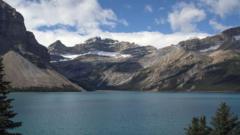What Happened in Banff: Hiker Killed in Rockfall Rescue Efforts?

Tragedy in Banff National Park: Understanding the Risks of Hiking and Rockfalls
In a devastating incident that has shocked the hiking community and nature lovers alike, one person has lost their life following a rockfall that struck several hikers on the Bow Glacier Falls trail in Banff National Park. This tragic event underscores the inherent risks associated with outdoor activities, particularly in mountainous terrains where rockslides can occur with little warning. As the search for potential survivors continues, it is crucial to understand the dynamics of rockfalls, the safety measures hikers can take, and the significance of national parks as natural treasures.
The Incident: What Happened at Bow Glacier Falls?
On Thursday afternoon, a rockfall occurred north of Lake Louise, a picturesque tourist town located 124 miles (200 km) northwest of Calgary, Alberta. The Bow Glacier Falls hiking trail, which stretches approximately six miles (9 km) along Bow Lake, is classified as a moderate challenge, attracting both seasoned hikers and those seeking a memorable outdoor experience.
The rockfall resulted in one fatality and left three individuals injured, with their conditions undisclosed in a joint statement released by Parks Canada and the Lake Louise Royal Canadian Mounted Police (RCMP). Eyewitness accounts describe a harrowing scene, with large boulders tumbling down and clouds of dust enveloping the area.
Ron Hallman, president and CEO of Parks Canada, expressed condolences, stating, "We are all heartbroken by the recent tragedy at Bow Glacier Falls. My thoughts are with the families and friends of those affected." Meanwhile, Alberta Premier Danielle Smith shared her sentiments on social media, emphasizing the collective hope for the safety of everyone involved.
The Nature of Rockfalls: Causes and Risks
Rockfalls are a natural phenomenon that can occur in mountainous areas due to a variety of factors, including:
- Weather Conditions: Heavy rainfall, rapid snowmelt, and freeze-thaw cycles can weaken rock formations and trigger collapses.
- Geological Factors: The type of rock, its structure, and the slope's angle can influence the likelihood of a rockfall.
- Human Activity: Increased foot traffic and construction activities can destabilize the surrounding rock.
In Banff National Park, where dramatic landscapes create breathtaking views, the risk of rockfalls is ever-present. Hikers must remain vigilant and prepared for changing conditions, as nature can be unpredictable.
Safety Measures for Hikers
While hiking can be an exhilarating experience, it is essential to prioritize safety. Here are some crucial tips for hikers to minimize risks:
1. Research Trails Thoroughly
Before embarking on a hike, familiarize yourself with the trail. Check official park websites for alerts regarding trail conditions, closures, and hazards.
2. Understand Weather Patterns
Weather can change rapidly in mountainous regions. Always check the forecast and be prepared for sudden changes, especially during the rainy season.
3. Stay Aware of Your Surroundings
Pay attention to your environment. Look for signs of instability in rock formations and avoid areas that appear prone to landslides.
4. Hike in Groups
Hiking with others increases safety. If an incident occurs, having companions can facilitate quicker responses and support.
5. Equip Yourself with Safety Gear
Wear sturdy shoes, carry a first-aid kit, and consider bringing a helmet when navigating rocky terrains.
The Role of Parks Canada in Ensuring Safety
Parks Canada plays a vital role in maintaining the safety and integrity of national parks. Their responsibilities include:
- Monitoring Natural Hazards: Parks Canada continuously assesses the risks associated with natural events, providing updates to the public.
- Implementing Safety Protocols: The agency enforces guidelines designed to protect both visitors and wildlife.
- Educating the Public: Through various outreach initiatives, Parks Canada aims to increase awareness about the risks associated with outdoor activities.
Understanding the Importance of National Parks
National parks like Banff are not just recreational areas; they are vital ecosystems that preserve biodiversity and offer a sanctuary for wildlife. The beauty and majesty of these parks draw millions of visitors each year, providing opportunities for outdoor enthusiasts to connect with nature.
However, the increasing popularity of these natural spaces raises concerns regarding environmental sustainability and visitor safety. Balancing the preservation of these landscapes with the need for public access is a challenge that national park authorities must navigate.
Community Response and Support
In the wake of the tragedy at Bow Glacier Falls, the community has rallied to support those affected. Local organizations and authorities are providing assistance to the injured and the families of the deceased. Furthermore, discussions surrounding the need for enhanced safety protocols and better communication of risks for hikers have gained traction.
Conclusion: Reflecting on the Risks and Rewards of Hiking
The heartbreaking incident at Bow Glacier Falls serves as a stark reminder of the unpredictable nature of the wilderness. While hiking offers unparalleled experiences and breathtaking views, it is crucial to remain aware of the associated risks. By understanding the dynamics of rockfalls, adhering to safety measures, and respecting the natural environment, hikers can continue to enjoy the beauty of national parks while minimizing dangers.
As we reflect on this tragedy, it is essential to honor the memories of those affected and to advocate for safer outdoor experiences. In the spirit of adventure and respect for nature, let us continue to explore the great outdoors, armed with knowledge and awareness.
Frequently Asked Questions
What are the signs of a potential rockfall while hiking?
Signs of a potential rockfall can include loose rocks, cracks in the rock face, and recent rock debris at the base of cliffs. Pay attention to unusual sounds or vibrations as well.
How can I prepare for hiking in mountainous areas?
Preparation includes researching the trail, checking weather conditions, bringing adequate gear, and ensuring you have a first aid kit and emergency supplies.
What should I do if I encounter a rockfall while hiking?
If you encounter a rockfall, seek shelter behind a solid object, stay calm, and assess your surroundings. Once safe, move away from the area and report the incident to park authorities.
As we navigate the joys and challenges of hiking, how can we further improve safety in our national parks? #HikingSafety #BanffNationalPark #RockfallAwareness
Published: 2025-06-20 16:25:10 | Category: wales



